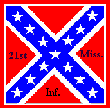

William J. Bryant (lineal ancestor, maternal
great-grandfather) volunteered with the Hurricane Rifles of Wilkinson County,
Mississippi.. The unit was
organized into Company E of the 21st
Mississippi Infantry Regiment on 1 June 1861 and was tendered
to President Jefferson Davis for Confederate service for the duration of
the war. Wm. J. Bryant had been the
county surveyor in Wilkinson County for a number of years prior to the war so he
was well known to most of the populace. As
a result of the way in which the company was formed and his being known by most
of the company volunteers, he was elected to be Lieutenant for the company.
Later, when the company had been given a Confederate army assignment, he
was promoted to Captain. It is not
known if he was not a very hale and hearty person physically or whether he
suffered some partially debilitating illness, but he was given the designation
of Captain Commissary which meant he performed duties much like a quartermaster,
procuring supplies and performing similar duties.
The Hurricane Rifles company was dispatched to Virginia as
soon as possible after formation and placed into the 1st Battalion
Mississippi Volunteers. The unit in
battalion configuration and designation was present at (First) Manassas.
Over the next several months the unit was brigaded with others in
several different unit designations but finally was designated the
21st Mississippi Infantry Regiment.
The regiment participated in picket duties on the
Chickahominy and came under fire at Seven Pines, suffering some losses.
During 1862 and early 1863 some companies of the 21st were put
on detached (sub-regimental) assignment. None
of these detached service occurrences were associated with any major battles,
however.
WJB’s duties as Captain Commissary resulted in him being
a part of regimental staff and not directly connected to his original company,
i.e., he was a Captain, the rank of a company commander, but he did not command
Co. E. Also, his duty as a
procurer of supplies and materiel, particularly foodstuffs and personal-issue
items, e.g. candles, removed him from direct participation in much of the
battlefield action.
The 21st participated
in actions at Malvern Hill, Maryland Heights, and Sharpsburg (Antietam to the
Yankees) where they saw distinguished service in driving the Federals from the
woods in front of the brigade and pursuing them some distance in their retreat
across open fields. At Fredericksburg, the 21st had a significant
role in stalling the Federals’ building of pontoon bridges thereby retarding
their ability to bring up support troops as quickly as needed.
The 21st was in battle again at Fredericksburg
the next spring as a part of the Battle of Chancellorsville, specifically at the
Marye house (or hill). The next
major action, probably the most memorable, was as a part of
Barksdale’s Brigade at Gettysburg in the assault on the peach orchard
against Sickles on July 2, 1863. After
a stubborn battle, Sickles was driven into the wheat field where an even more
desperate and violent struggle ensued during which Barksdale fell mortally
wounded. The 21st
pressed further into the Yankee position than any other regiment and was the
only unit to cross Plum Run (Creek) and press the battle to the very base of
Little Round Top. The brigade
suffered the greatest loss of any of Longstreet’s units, greater even than the
losses of those assaulting the
Devil’s Den and slopes of Little Round Top.
Following a relatively brief recovery period, the regiment
was one of those sent west under Longstreet to counter the Federals at
Chickamauga. The unit then went
into the siege of Chattanooga for a time, moved then to action near Knoxville
and returned to the Army of Northern Virginia in the spring of 1864 where it was
involved at the Wilderness seeing distinguished service in pressing the Federals
hard on the field while suffering substantial casualties.
The 21st then went into battle against Grant’s pressing
offensive toward Richmond at Gaines’ Mill and Cold Harbor.
It then entered service in the
defense lines at Petersburg then at Richmond during the siege.
The unit then was sent to reinforce Early’s forces in the Shenandoah
Valley. In November, 1864, it
returned to Richmond and remained there until evacuation.
The 21st was among the units surrendered at Appomattox.
Records of WJB’s service throughout the entire war have
not been found; therefore, his date of release from Confederate service is not
known. My maternal Grandfather Van
Bryant was born in 1871; therefore, we know that WJB returned home hale and hearty enough to sire children.
No photos of William J. Bryant are known to exist.

Source: Military
History of Mississippi, 1803 - 1898 by Dunbar Rowland